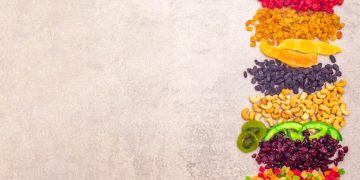The Truth About Sugar: How Much Is Too Much? A Complete Guide

The Truth About Sugar: How Much Is Too Much and How to Cut Back explores the types of sugars, their sources, and provides guidelines on healthy consumption limits. It also offers practical strategies for reducing sugar intake in your daily diet, promoting better health and well-being.
The sweet allure of sugar is undeniable, but understanding the truth about sugar: how much is too much and how to cut back is crucial for maintaining optimal health. From hidden sugars in processed foods to the natural sugars in fruits, navigating the world of sweeteners can be tricky. Let’s dive into how much sugar is safe, what it does to your body, and actionable steps to reduce your intake.
Understanding the Different Types of Sugar
When we talk about sugar, it’s easy to think of the granulated white stuff. However, the truth about sugar: how much is too much and how to cut back, requires a deeper look at the variety of sugars present in our diet. Understanding these different forms is crucial for making informed choices and managing our intake effectively.
Added Sugars vs. Natural Sugars
Added sugars are those that are incorporated into foods and beverages during processing. Natural sugars, on the other hand, occur naturally in fruits, vegetables, and dairy products.
Common Types of Added Sugars
- High-Fructose Corn Syrup: A pervasive sweetener in processed foods and beverages.
- Sucrose: Table sugar, commonly used in baking and beverages.
- Glucose: A simple sugar that the body uses for energy.
- Fructose: Found in fruits and honey, and also used as a sweetener.
Understanding the source and type of sugar helps in making healthier dietary choices. Opting for foods with natural sugars and limiting those with added sugars can significantly impact your overall health.
How Much Sugar Is Too Much? Recommended Daily Limits
Determining “how much is too much” is a significant aspect of the truth about sugar: how much is too much and how to cut back. Health organizations provide guidelines to help individuals make informed decisions about their sugar consumption, keeping it within reasonable and safe limits.
American Heart Association Guidelines
The American Heart Association (AHA) recommends limiting added sugar intake to no more than 6 teaspoons (25 grams) per day for women and 9 teaspoons (36 grams) per day for men.
World Health Organization Recommendations
The World Health Organization (WHO) suggests that adults and children reduce their daily intake of free sugars to less than 10% of their total energy intake. A further reduction to below 5% of total energy intake would provide additional health benefits.
It’s important to note that these recommendations refer to added sugars, not the natural sugars found in fruits and vegetables. Being mindful of these limits can help you maintain a healthier lifestyle and reduce the risk of various health issues.
The Negative Health Effects of Excessive Sugar Consumption
Excessive sugar consumption has been linked to numerous health problems, highlighting the importance of understanding the truth about sugar: how much is too much and how to cut back. From weight gain to chronic diseases, the impact of too much sugar on the body can be profound.
Weight Gain and Obesity
High sugar intake contributes to weight gain by providing excess calories that the body doesn’t need. These excess calories are often stored as fat, leading to obesity and associated complications.
Type 2 Diabetes
Consuming too much sugar can lead to insulin resistance, a condition where the body’s cells become less responsive to insulin. This can eventually result in type 2 diabetes, a chronic disease that affects how your body metabolizes sugar.
Heart Disease
Studies have shown that high sugar intake is associated with increased risk factors for heart disease, including high blood pressure, high triglyceride levels, and inflammation. Cutting back on sugar can help reduce these risk factors.
Other Health Issues
- Dental Problems: Sugar feeds bacteria in the mouth, leading to tooth decay and cavities.
- Liver Problems: Excessive fructose intake can lead to non-alcoholic fatty liver disease (NAFLD).
- Increased Risk of Cancer: Some studies suggest a link between high sugar intake and certain types of cancer.
By being aware of these potential health issues, you can take proactive steps to reduce your sugar intake and protect your overall well-being.
Identifying Hidden Sugars in Everyday Foods
One of the biggest challenges in managing sugar intake is identifying hidden sugars in everyday foods, which is a crucial part of understanding the truth about sugar: how much is too much and how to cut back. Many processed foods contain added sugars that you might not be aware of.
Reading Food Labels
Becoming proficient at reading food labels is essential. Look for terms like “high-fructose corn syrup,” “sucrose,” “glucose,” and “dextrose” in the ingredient list. Also, check the “added sugars” line on the nutrition facts label.
Common Culprits
Certain food items are notorious for containing hidden sugars. Be wary of:
- Breakfast Cereals: Many cereals, especially those marketed to children, are loaded with added sugars.
- Sauces and Dressings: Ketchup, salad dressings, and barbecue sauces often contain high amounts of sugar.
- Yogurt: Flavored yogurts can be surprisingly high in sugar, so opt for plain yogurt and add your own fruit.
- Bread: Some breads, particularly white bread and sweet rolls, contain added sugars.

By educating yourself about common sources of hidden sugars, you can make more informed choices and reduce your overall sugar consumption.
Practical Strategies for Cutting Back on Sugar
Cutting back on sugar doesn’t have to be a daunting task. With some practical strategies, you can gradually reduce your intake and develop healthier habits, which is key in learning the truth about sugar: how much is too much and how to cut back. Here are several tips to get you started:
Gradual Reduction
Start by gradually reducing the amount of sugar you add to your coffee or tea. Over time, you’ll likely find that you don’t miss the sweetness as much.
Swap Sugary Drinks for Healthier Options
Sugary drinks like soda, juice, and sweetened beverages are significant contributors to added sugar intake. Replace them with water, unsweetened tea, or sparkling water.
Choose Whole, Unprocessed Foods
Focus on eating whole, unprocessed foods like fruits, vegetables, lean proteins, and whole grains. These foods are naturally low in added sugars and provide essential nutrients.
Cook at Home More Often
Cooking at home allows you to control the ingredients and avoid hidden sugars found in many processed foods. Experiment with sugar-free recipes and use natural sweeteners like stevia or erythritol sparingly.
Read Labels Carefully
Make it a habit to read food labels and choose products with lower amounts of added sugars. Be aware of the various names for sugar, such as high-fructose corn syrup, sucrose, and dextrose.
Implementing these strategies can help you effectively reduce your sugar consumption and improve your overall health.
Healthy Sugar Substitutes and Alternatives
For those looking to reduce their sugar intake without sacrificing sweetness, there are several healthy sugar substitutes and alternatives to consider. Understanding these options is important in mastering the truth about sugar: how much is too much and how to cut back.
Natural Sweeteners
Natural sweeteners like:
- Stevia: A plant-based sweetener with zero calories.
- Erythritol: A sugar alcohol with minimal calories and a low glycemic index.
- Monk Fruit: A natural sweetener derived from monk fruit, with no calories.
Artificial Sweeteners
Artificial sweeteners like:
- Aspartame: A low-calorie sweetener used in many diet products.
- Sucralose: A zero-calorie sweetener derived from sugar.
- Saccharin: One of the oldest artificial sweeteners, also with zero calories.
When using sugar substitutes, it’s important to do so in moderation. While they can be a helpful tool, they are not a replacement for a balanced and nutritious diet. Consider consulting with a healthcare professional or registered dietitian to determine the best options for your individual needs.
| Key Point | Brief Description |
|---|---|
| 🍬 Types of Sugar | Learn to differentiate between natural and added sugars. |
| ⚠️ Health Risks | Excess sugar can lead to weight gain, diabetes, and heart disease. |
| 🔎 Hidden Sugars | Check food labels for added sugars in everyday items. |
| 🥤 Reduce Intake | Swap sugary drinks for alternatives and cook at home more often. |
Frequently Asked Questions About Sugar
Added sugars are incorporated during processing, while natural sugars occur in fruits and dairy. Added sugars should be limited, while natural sugars are part of a healthy diet.
The American Heart Association recommends no more than 6 teaspoons (25 grams) per day for women and 9 teaspoons (36 grams) per day for men of added sugars.
Excessive sugar intake can lead to weight gain, type 2 diabetes, heart disease, dental problems, liver issues, and an increased risk of certain cancers.
Read food labels carefully, looking for terms like high-fructose corn syrup, sucrose, and dextrose. Be aware of common culprits like breakfast cereals and sauces.
Consider using natural sweeteners like stevia, erythritol, and monk fruit in moderation. Artificial sweeteners like aspartame and sucralose are also options, but use them sparingly.
Conclusion
Understanding the truth about sugar: how much is too much and how to cut back is crucial for maintaining good health. By being mindful of the types of sugars you consume, reading food labels, and implementing practical strategies to reduce your intake, you can enjoy a balanced diet and minimize the negative health effects associated with excessive sugar consumption.





